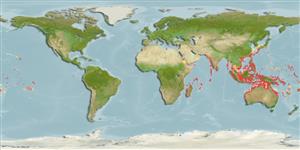Common names from other countries
>
Gobiiformes (Gobies) >
Gobiidae (Gobies) > Gobiinae
Etymology: Valenciennea: From Achille Valenciennes 1794-1865; he worked with Duméril, Cuvier and Lacepède since 1815; malacologist, author of a "Histoire naturelle des poissons" (Ref. 45335).
More on author: Bleeker.
Environment: milieu / climate zone / depth range / distribution range
Ecologia
marinhas associadas(os) a recifes; intervalo de profundidade 1 - 45 m (Ref. 48637), usually 1 - 30 m (Ref. 27115). Tropical; 22°C - 27°C (Ref. 27115); 44°N - 29°S, 32°E - 138°W
Indo-West Pacific: southern Red Sea (Ref. 34105) and East Africa (where common, Ref. 9710) to Indonesia, north to southern Japan (Ref. 9710), south to the Great Barrier Reef (Ref. 2334).
Tamanho / Peso / Idade
Maturity: Lm ? range ? - ? cm
Max length : 25.0 cm TL macho/indeterminado; (Ref. 9002); common length : 18.0 cm TL macho/indeterminado; (Ref. 9002)
Espinhos dorsais (total): 7; Raios dorsais (total): 11; Espinhos anais 1; Raios anais : 11. Characterized by pale grey body color with broad white midlateral stripe bordered by pair of black to brownish stripes; first dorsal fin with large black spot; truncate to slightly emarginate caudal fin, ray above and below central three rays prolonged as filament in adult; length of caudal fin 2.4-5.0 in SL; longitudinal scale series 127-146; ctenoid body scales except cycloid on abdomen; head or midline of nape without scales; in adult, cycloid scales extending forward on side of nape to above middle of operculum; base of pectoral fin and prepelvic area scaled in adult; depth of body 5.0 in SL (Ref. 90102).
A relatively rare species occurring singly but usually in pairs over silty flat sand patches, or rubble substrates; a mound-building species. Usually found on outer reefs at the bottom of coral or rocky drop-offs, rarely in lagoons. Feeds on small burrowing animals by sifting mouthfuls of sand. Monogamous (Ref. 34105, 48637, 52884). Eggs hatched 2 days after spawning in aquaria; 35 days after, the larvae reached 5.25 mm.
Ciclo de vida ou comportamento de acasalamento
Maturidade | Reprodução | Desova | Ovos | Fecundidade | Larvas
Monogamous mating is observed as both obligate and social (Ref. 52884).
Hoese, D.F. and H.K. Larson, 1994. Revision of the Indo-Pacific gobiid fish genus Valenciennea, with descriptions of seven new species. Indo-Pac. Fish. (23):71 p. (Ref. 8527)
Status na Lista Vermelha da UICN (Ref. 130435)
CITES (Ref. 128078)
Not Evaluated
Ameaça para os humanos
Harmless
Uso pelos humanos
Aquário: Espécies comerciais
Mais informação
ReferênciasAquaculturaPerfil para aquaculturaEstirpesGenéticaElectrophoresesHereditariedadeDoençasProcessamentoConversão de massa
Ferramentas
Relatórios especiais
Baixar XML
Fontes da internet
Estimates based on models
Preferred temperature (Ref.
115969): 24.4 - 29, mean 27.6 (based on 1254 cells).
Índice de diversidade filogenética (Ref.
82804): PD
50 = 0.5000 [Uniqueness, from 0.5 = low to 2.0 = high].
Bayesian length-weight: a=0.01023 (0.00477 - 0.02194), b=3.02 (2.84 - 3.20), in cm Total Length, based on LWR estimates for this (Sub)family-body shape (Ref.
93245).
Nível Trófico (Ref.
69278): 3.4 ±0.41 se; based on food items.
Resiliência (Ref.
120179): médio(a), tempo mínimo de duplicação da população 1,4 - 4,4 anos (Preliminary K or Fecundity.).
Fishing Vulnerability (Ref.
59153): Low vulnerability (15 of 100).
